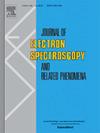边缘构型多样性对基于Ti3C2O2和Sc3C2F2的MXene之字形纳米带能隙的影响
IF 1.5
4区 物理与天体物理
Q2 SPECTROSCOPY
Journal of Electron Spectroscopy and Related Phenomena
Pub Date : 2025-02-26
DOI:10.1016/j.elspec.2025.147526
引用次数: 0
摘要
在这项研究中,我们报道了Ti3C2O2和Sc3C2F2之字形纳米带不同边缘的能带结构和能隙。结果表明,在大多数宽度的锯齿形纳米带中,即使宽度相同,不同边缘构型的能隙值也不同。在Ti3C2O2纳米带中,锯齿形纳米带边缘中心原子的存在增加了带隙;在Sc3C2F2纳米带中,根据纳米带宽度的不同,纳米带边缘中心原子或表面原子的存在都会增加带隙。Sc3C2F2纳米带的最大差异为0.3 eV, Ti3C2O2纳米带的最大差异为0.17 eV。依赖于边缘原子的带隙对于MXene纳米带在电子和光电子器件中的设计和使用是重要的。本文章由计算机程序翻译,如有差异,请以英文原文为准。
The effect of edge configurations diversity on the energy gap in MXene zigzag nanoribbons based on Ti3C2O2 and Sc3C2F2
In this study, we report the band structure and energy gap of different edges of Ti3C2O2 and Sc3C2F2 zigzag nanoribbons using tight-binding approximation. Our results show that in most widths of zigzag nanoribbons, the energy gap in different edge configurations has different values even though they have the same width. In Ti3C2O2 nanoribbons, the presence of central atoms at the edge of the zigzag nanoribbon increases the band-gap and in Sc3C2F2 nanoribbon, depending on the width of the nanoribbon, the presence of central atoms or surface atoms on the edge of the nanoribbon can increase the band-gap. The maximum difference reaches 0.3 eV in Sc3C2F2 nanoribbon and 0.17 eV in Ti3C2O2 nanoribbon. The band gap depending on the edge atoms can be important for the design and use of MXene nanoribbons in electronic and optoelectronic devices.
求助全文
通过发布文献求助,成功后即可免费获取论文全文。
去求助
来源期刊
CiteScore
3.30
自引率
5.30%
发文量
64
审稿时长
60 days
期刊介绍:
The Journal of Electron Spectroscopy and Related Phenomena publishes experimental, theoretical and applied work in the field of electron spectroscopy and electronic structure, involving techniques which use high energy photons (>10 eV) or electrons as probes or detected particles in the investigation.

 求助内容:
求助内容: 应助结果提醒方式:
应助结果提醒方式:


